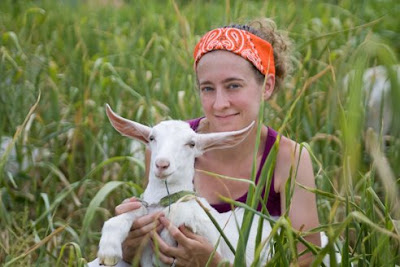
Yesterday we had a huge farm fried chicken lunch made by Chris.
You can probably figure out what that means...
I cut the throat of a rooster. It was a fairly disturbing experience. As you might have imagined, I have never cut the throat of any living (or dead) thing before. I reacted badly, to be honest.
The process went like this: we wrangled a bunch of brown hens that we suspected were old and not laying anymore. We put them all in a pen and each had a turn to spend three days in an isolated cage to lay an egg. If no egg was found in three days, the hens were transfered to a different pen: chicken death row. After we had collected about 20 hens in death row, we scheduled a day for the culling.
Part of me cringed at this process. It was not so much the fact that we were butchering the chickens for food, but the fact that we were trying to single out the females that didn't "produce" anymore. It reminded me of Josephine Bonaparte or miscellaneous wives of Henry VIII being done away with for being too old, lack of fertility or other ways in which they were deemed to be useless. We want you, but only for utilitarian purposes.
The morning of the culling had arrived (culling is a nice word for killing) and we were all set for the chickens we had brought down to the processing house. We were also ordered to butcher 2 roosters - they had attacked Matt's little daughter. If you are a rooster, it's not a good idea to attack a farm staff member's child, just for the record. We had a sawhorse set up with two attached buckets with holes in them big enough for the chickens to be put in upside-down so that their neck and head stuck out of the bottom. Once the throat was slit, someone had to stand there and hold the chicken as the body convulsed and the blood drained out. After a couple minutes the head was cut off and the body was submerged into hot water to loosen the feathers. Then, the body was put onto a fancy chicken plucker (we don't have many fancy, mechanical contraptions at the farm - this thing was donated). A wheel with rubber nipple-like things spun around and seemingly magically defeathered the chicken body. Next, the chicken feet were removed and the body was cut open at the bottom so all the guts could be pulled out. Lastly, you pop the chicken into a baggy and put it in the freezer.
We kicked off the culling with Matt's fancy rooster pictured in my previous post. The throat slitting and body convulsing part was fairly unpleasant to watch, so I happily volunteered for gut pulling. Once the chicken is dead and defeathered, it looks similar to what you might find in a grocery store, and that was more comforting than the feathers flying and blood flowing portion of the process. Gutting a chicken is not rocket science, but it did have its challenges. Once the bottom of the chicken was cut into, you had to carefully insert your hand into the body cavity as far back as it would go. You then had to begin pulling a mass of organs gently out of the body - careful not to puncture the intestines or gall bladder. A couple people squished the gall bladder too hard and fluorescent green goo went everywhere. Then the organs had to be sorted out - intestines and gall bladder in the trash, someone wanted the livers and gizzards to cook that night, and Chris wanted just about everything else to put into an esoteric Italian dish. And just so everyone is clear, the gizzard is the chicken stomach. The stomach has to be sliced, kind of like you are slicing a bagel, and turned inside-out. The contents of the stomach have to be emptied into the trash and the lining has to be peeled off. This is how it's done. It is for real.
As I was removing the organs of one of the chickens, Will, the chicken master, came over and exclaimed, "Wow! That looks like one healthy liver!" I love strangely placed enthusiasm. I wasn't sure if all the chickens were as equally healthy as that one. As I opened up the body of another I was shocked to find strange, gelatinous orbs floating around the organs. Was it tumors? Everyone rushed over to examine. Turns out, they were under-developed eggs. That chicken was vindicated only in death...
The time came for me to kill my rooster. I thought it would be good for me to experience the entire process, but I was growing more apprehensive. The rooster was put upside-down into the bucket and I took hold of his head. One quick stroke and he would be dead. I gave it a good go, but the knife was too dull and I hadn't cut deep enough. But I had sliced enough for the blood to start flowing and the body to begin writhing. I didn't want to do it again. I looked to Chris for help - he told me to give it another go myself. I pleaded with Samson, the intern from Ghana, to help and he just stood there with a blank look on his face. Apparently, Chris and Samson thought I should do it myself as some sort of organic farm, meat eater rite of passage or something. All I could think about was this was turning into a slow and painful death for this poor bird and no one would help this crazy girl dancing around, whining and crying, with a dull knife in her hand. So, I gave it two more good cuts and it was over.
I am now officially retired from chicken butchering.












































